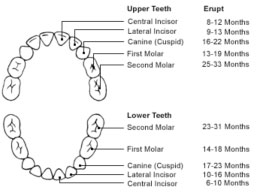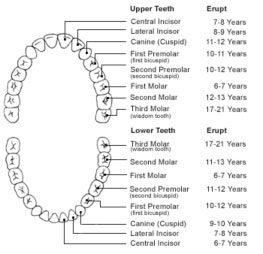
Pediatric Dentistry
Pediatric Dentistry
| Early Childhood Caries
Thumb-Sucking
| Pediatric Dentistry FAQs

When New Teeth Arrive
Your child's first tooth erupts between ages 6-12 months and the remainder of their 20 primary or "baby" teeth typically erupt by age 3. During this time, gums may feel tender and sore, causing your child to feel irritable. To help alleviate this discomfort, we recommend that you soothe the gums by rubbing a clean finger or a cool, wet cloth across them. You may also choose to make use of a teething ring. Do not give your child teething cookies as most contain starch and sugar which promotes tooth decay. Teething does not cause fevers. If your baby has a fever or diarrhea while teething, treat it appropriately as you would at any other time. Contact your family physician if you become concerned.

Your child's primary teeth are shed at various times throughout childhood, and their permanent teeth begin erupting at age 6 and continue until age 21. Adults have 28 permanent teeth, or 32 including wisdom teeth.
Adopting Healthy Oral Hygiene Habits
As new teeth erupt, examine them every two weeks for lines and discolouration caused by decay. Remember that sugary foods and liquids can attack a new tooth, so take care that your child brushes his teeth after feeding or eating. We recommend brushing four times a day for optimal oral hygiene: after breakfast, after lunch, after dinner, and at bedtime. Brushing can be fun, and your child should brush as soon as the first tooth arrives. When a baby's tooth erupts, parents should brush the tooth with a soft-bristled toothbrush and a pea-sized amount of toothpaste. We suggest reviewing proper tooth brushing procedures with your child.
Flossing is also a part of good oral hygiene habits, and your doctor will discuss with you the right time to start flossing. If you notice signs of decay, contact your dentist immediately.
Brushing: Step 1
Place your toothbrush at a 45 degree angle to your gum.
Brushing: Step 2
Brush gently in a circular motion.
Brushing: Step 3
Brush the outer, inner, and chewing surfaces of each tooth.
Brushing: Step 4
Use the tip of your brush for the inner surface of your front teeth.
Flossing: Step 1
Wind about 18 inches of floss around your fingers as shown. Most of it should be wrapped around one finger, and as the floss is used, the other finger takes it up.
Flossing: Step 2
Use your thumbs and forefingers to guide about one inch of floss between your teeth.
Flossing: Step 3
Holding the floss tightly, gently saw the floss between your teeth. Then curve the floss into a C-shape against one tooth and gently slide it beneath your gums.
Flossing: Step 4
Slide the floss up and down, repeating for each tooth.
Preventing Tooth Decay
Tooth decay is preventable. Tooth decay is caused by sugars left in your mouth that turn into an acid which can break down your teeth. Children are at high risk for tooth decay for a simple reason — many children and adolescents tend to be lax in their oral hygiene habits. Proper brushing and flossing routines combined with regular dental visits help keep tooth decay away. A low-sugar diet also helps keep tooth decay at bay.
Your child should visit the dentist every 6 months for regular dental cleanings and checkups. We recommend fluoride treatments twice a year along with cleanings to keep teeth their strongest. Tooth sealants are also recommended because they "seal" the deep grooves in your child's teeth, preventing decay from forming in these hard-to-reach areas. Sealants last for several years, but will be monitored at your regular checkups.


